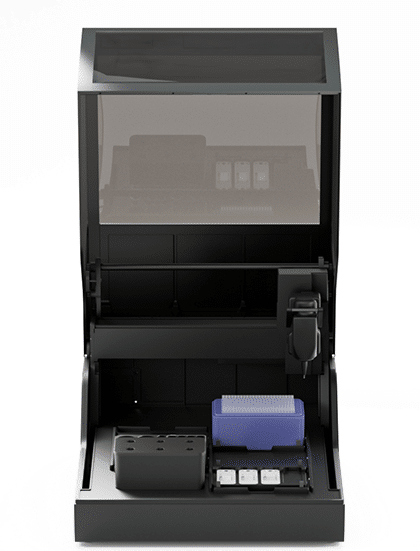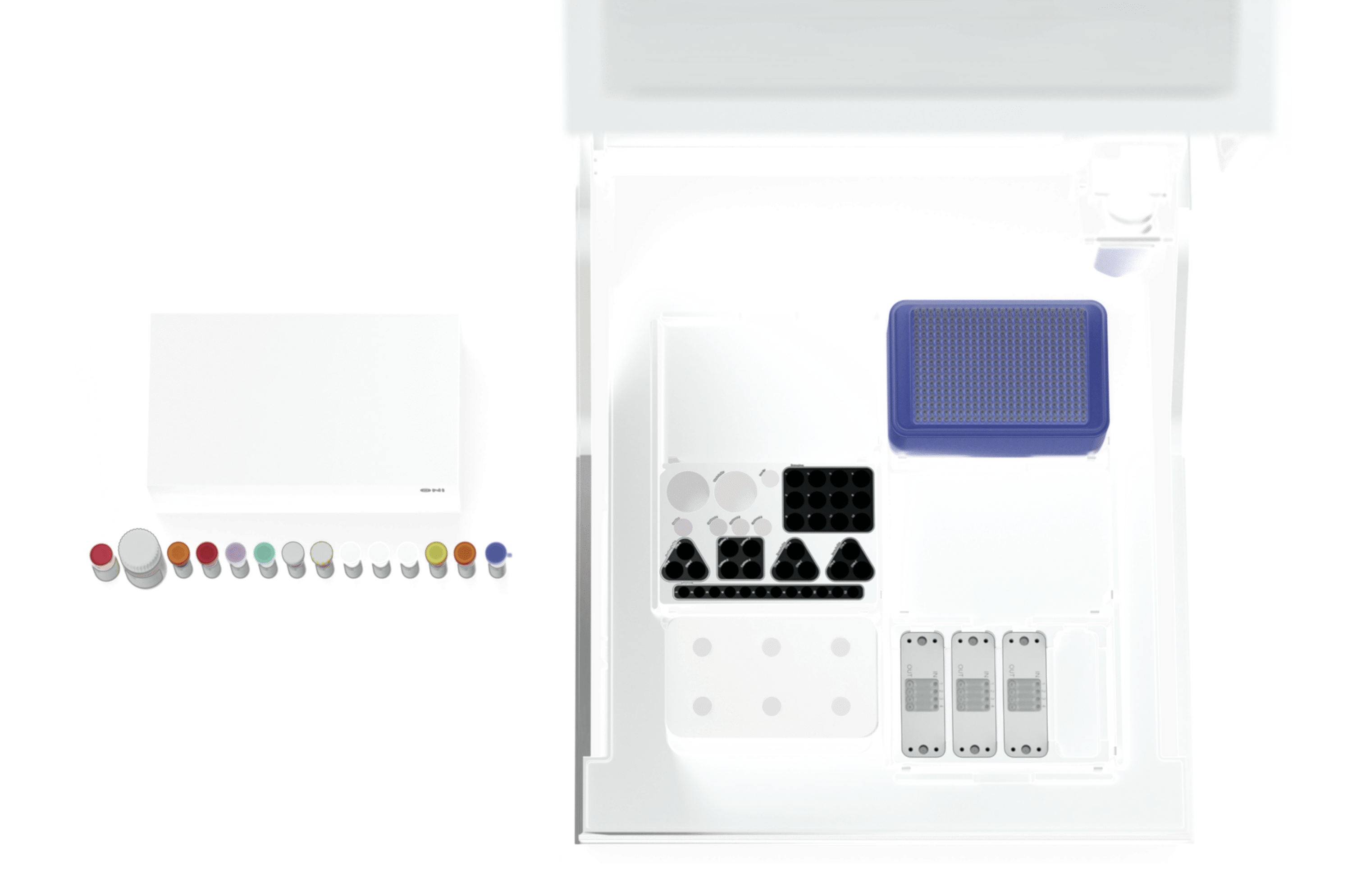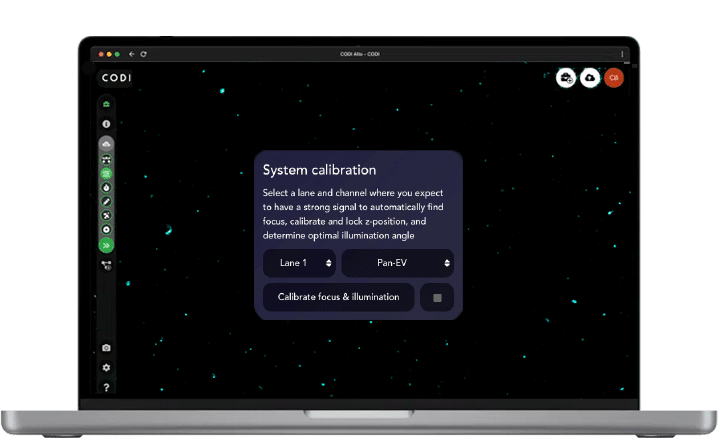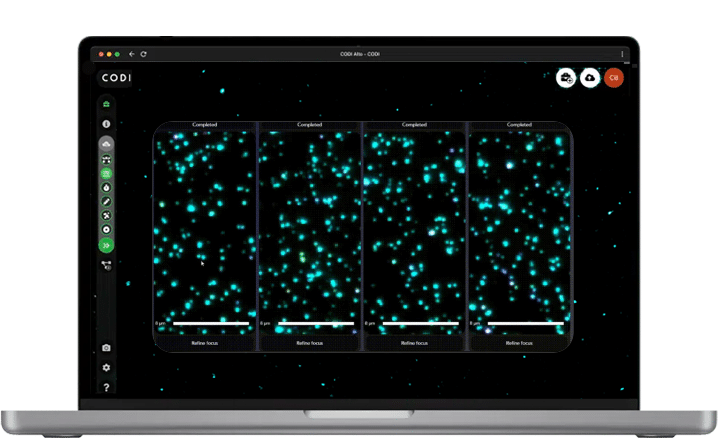Upcoming Virtual dSTORM Training – Coming January 29, 2026 register now>
Aplo Flow
Automated sample preparation
Aplo Flow
Super-resolution simplified
Aplo Flow revolutionizes the world of super-resolution microscopy by combining application-specific sample preparation with fully automated fluidic control, creating the most user-centric, reliable, and reproducible end-to-end solution on the market today. With minimized hands-on time, the entire super-resolution workflow from ‘sample to answer’ is united under ONI’s seamless integration of fluidics, SMLM, reagent kits, and software analysis.
With Aplo Flow, super-resolution microscopy is now simplified.
Enhanced throughput and modular design
Aplo Flow streamlines super-resolution microscopy, enhancing both speed and efficiency. It can prepare 12 samples for imaging in only 4.5 hours, reducing your hands-on time by up to 85% per sample. Our end-to-end product accelerates analysis and interpretation by 350%. With 35 unique configurations, it suits diverse research needs and protocols.

One system, two modes of operation

Automated sample preparation
Streamline your workflow by automating the preparation of multiple samples in parallel on the deck of the Aplo Flow system. Start imaging immediately after a preparation, or store samples at 4°C for imaging the next day. Aplo Flow is designed to speed up your time to results and maintain assay flexibility while simultaneously reducing hands on time by up to 85% per sample.
Available for Aplo Scope and Nanoimager today.

Fluidics microscopy
Unlock new possibilities through active fluidic tethering of your Aplo Flow system to a fluidics chip on a stage of the Aplo Scope. Execute fully automated sample preparations, and immediately proceed to visualize dynamic processes in drug delivery, particle binding, and more.
Available in a future release for Aplo Scope.
Key features
Aplo Flow


Get a closer look
AutoEV: EV acquisition, analysis and reporting software

Experiment setup
The software has default settings tailored for each variant of the kit. All you need to do is inform the software about your specific reagents, and it will automatically adjust the acquisition settings accordingly. Additionally, users have the flexibility to select and apply specific analysis settings after the imaging process, providing a flexible and efficient experience.

One-click channel mapping
Channel mapping is a simple, one-click step!

One-click system calibration
The system is designed for automatic calibration processes, aimed to enhance data consistency and reproducibility across lanes and chips. These processes include autofocus, automatic-Z-lock, and auto-TIRF, all of which contribute to optimized system performance. The system considers the specific properties of the analyzed sample and automatically determines the appropriate settings. The user simply selects a specific lane and imaging channel where they expect a robust signal for the system calibration, streamlining the overall imaging experience, however, the system also allows for manual settings if the user prefers.

Sample check
The system facilitates a rapid assessment of key features within minutes including the density of EVs in the sample, their distribution and the efficacy of biomarker staining. This step ensures the quality and the reliability of the sample before the full imaging process. If necessary, users have the option to modify the autofocus settings on a per-lane basis, based on the insights they gained from the images. This adaptive approach allows for fine-tuning and optimization in real-time, ultimately contributing to the accuracy and the precision of the imaging results.

Automatic 4-lane acquisition
Users have to flexibility to choose their preferred fields of view (FOV) for imaging or opt for the FOVs recommended by our expert development scientists. The process is streamlined to efficiently and automatically image a 4-lane chip within 90 minutes. Users can access information about the EV count within minutes, thanks to the system’s real-time analysis capabilities. This features provides users with immediate insights, enhancing the overall efficiency and and responsiveness of the imaging workflow.

Summary page & EV mosaic
Upon completion of the 4-lane acquisition, a mosaic summary view offers a visual representation of the biomarker heterogeneity at the single EV level. This feature enables users to swiftly navigate through different EVs of the same positivity class by clicking on next/previous options. Positioned at the bottom of each lane, this mosaic view facilitates a convenient visual comparison of EVs across various conditions. The immediate insights gained from this overview aid in determining the success of the acquisition process.

Custom 1-page EV report
By selecting “Generate Report”, the user can quickly generate a concise 1-page report, featuring three essential, easily comparable metrics. This report provides valuable insight on the quality of your sample, including EV count, biomarker heterogeneity count, and EV size. The metrics are presented at both the population level and according to each biomarker positivity, offering a comprehensive overview of the sample characteristics for efficient analysis and decision-making.
EV characterization and biomarker visualization redefined

Be confident your EVs are really EVs
EV Profiler 2 includes ONI’s Pan-EV Detection and pooled Tetraspanin Trio reagents. This combination ensures the exclusion of contaminating particles or antibody aggregates from the analysis.
Key outputs:
- Identification of true EVs through the utilization of ONI’s Pan-EV Detection reagent
- Tetraspanin Trio Detection reagents ensures precise analysis, excluding contaminating particles and antibody aggregates
- EV Profiler 2’s advanced features support the 2023 MISEV guidelines enabling orthogonal characterization of EV samples with a robust and reliable EV analysis workflow

Visualize and size your EVs accurately, quickly and easily
Quick and unbiased visualization and sizing of EVs through the pan-EV stain, reveals both membrane and shape details for a comprehensive analysis of their dimensions and characteristics.
Key outputs:
- Visualization of EVs providing a clear and detailed view of the EV membranes with sizing comparable to TEM, but faster and from your labs benchtop
- The pan-EV stain labels EV membranes, ensuring unbiased sizing for accurate dimension information
- Unveil the shape of EVs, and have a more comprehensive understanding of their characteristics

Detect and visualize biomarkers inside or on the surface of EVs
Detect and visualize biomarkers inside and on the surface of EVs, allowing for efficient phenotyping and insight into biomarker clustering.
Key outputs:
- Label samples in stunning 3-color super-resolution and assay for cargo or surface biomarkers all in one kit
- Reveal the clustering of biomarkers on or within EVs, offering a more detailed understanding of their distribution

Co-localize up to three biomarkers
EV Profiler 2 detects biomarkers in up to three channels, enabling measurement of single, double, and triple positivity on individual EVs with a 10% SD between assay chips.
Key outputs:
- Assay for size and positivity by combining Pan-EV, Pooled Tetraspanin Trio, and a biomarker of your interest or analyze each independent Tetraspanin in its own channel
- A validated antibody panel including anti-CD9 (488), anti-CD63 (561) and anti-CD81 (647) can be purchased as an add on
- Biomarker positivity across multiple chips and lanes (left) falls below 10% standard deviation when measuring single, double, and triple positivity for CD9, CD63, and CD81
Ready to purchase?
Explore
Providing tools to make super-resolution microscopy more accessible.
FAQs
Aplo Flow enhances workflow efficiency by fully automating sample preparation for any of ONIs custom reagent kits. With less than 30 minutes of hands on time, even a novice scientist can prepare 12 samples with high reliability and consistency. Then, instead of spending hours preparing samples by hand, Aplo Flow users are free to image other samples, analyze yesterday’s dataset, or plan their next experiment. More answers in less time – the true meaning of efficiency.
Users can choose to process anywhere from 1 sample up to 12 in a single run (3x chips with 4x lanes on each), indicating custom experimental conditions for each lane before starting the experiment.
Aplo Flow’s modular experimental design provides versatility with 35 unique configurations possible per sample, catering to various research needs and protocols, ensuring adaptability and scalability for diverse scientific applications.
Users of Aplo Flow have access to comprehensive support and resources, including training materials, technical assistance, and software updates. This ensures that researchers can maximize the capabilities of Aplo Flow and achieve their scientific goals efficiently and effectively.

